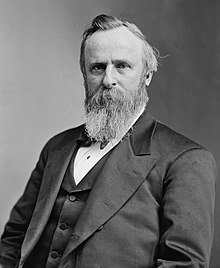
Rutherford B. Hayes
From Wikipedia, the free encyclopedia
| Rutherford B. Hayes | |
|---|---|
 | |
| 19th President of the United States | |
| In office March 4, 1877 – March 4, 1881 | |
| Vice President | William Wheeler |
| Preceded by | Ulysses Grant |
| Succeeded by | James Garfield |
| 29th and 32nd Governor of Ohio | |
| In office January 10, 1876 – March 2, 1877 | |
| Lieutenant | Thomas Young |
| Preceded by | William Allen |
| Succeeded by | Thomas Young |
| In office January 13, 1868 – January 8, 1872 | |
| Lieutenant | John Lee |
| Preceded by | Jacob Cox |
| Succeeded by | Edward Noyes |
| Member of the U.S. House of Representatives from Ohio's 2nd district | |
| In office March 4, 1865 – July 20, 1867 | |
| Preceded by | Alexander Long |
| Succeeded by | Samuel Cary |
| Personal details | |
| Born | Rutherford Birchard Hayes October 4, 1822 Delaware, Ohio, U.S. |
| Died | January 17, 1893 (aged 70) Fremont, Ohio, U.S. |
| Political party | Republican (1854–1893) |
| Other political affiliations | Whig (Before 1854) |
| Spouse(s) | Lucy Webb |
| Children | Birchard, Webb, Rutherford, Joseph, George, Fanny, Scott, Manning |
| Alma mater | |
| Profession | Lawyer |
| Religion | Methodism |
| Signature | |
| Military service | |
| Allegiance | |
| Service/branch | |
| Years of service | 1861–1865 |
| Rank | Brevet major general |
| Unit | |
| Battles/wars | American Civil War |
Rutherford Birchard Hayes (October 4, 1822 – January 17, 1893) was the 19th President of the United States (1877–1881). As president, he oversaw the end of Reconstruction and the United States' entry into the Second Industrial Revolution. Hayes was a reformer who began the efforts that led to civil service reform and attempted, unsuccessfully, to reconcile the divisions that had led to the American Civil War fifteen years earlier.
Born in Delaware, Ohio, Hayes practiced law in Lower Sandusky (now Fremont) and was city solicitor of Cincinnati from 1858 to 1861. When the Civil War began, Hayes left a successful political career to join the Union Army. Wounded five times, most seriously at the Battle of South Mountain, he earned a reputation for bravery in combat and was promoted to the rank ofmajor general. After the war, he served in the U.S. Congress from 1865 to 1867 as a Republican. Hayes left Congress to run for Governor of Ohio and was elected to two consecutive terms, serving from 1867 to 1871. After his second term had ended, he resumed the practice of law for a time, but returned to politics in 1875 to serve a third term as governor.
In 1876, Hayes was elected president in one of the most contentious and hotly disputed elections in American history. Although he lost the popular vote to Democrat Samuel J. Tilden, Hayes won the presidency by the narrowest of margins after a Congressional commission awarded him twenty disputed electoral votes. The result was the Compromise of 1877, in which the Democrats acquiesced to Hayes's election and Hayes accepted the end of military occupation of the South.
Hayes believed in meritocratic government, equal treatment without regard to race, and improvement through education. He ordered federal troops to quell the Great Railroad Strike of 1877 and ordered them out of Southern capitals as Reconstruction ended. He implemented modest civil service reforms that laid the groundwork for further reform in the 1880s and 1890s. Hayes kept his pledge not to run for re-election. He retired to his home in Ohio and became an advocate of social and educational reform.
No comments:
Post a Comment